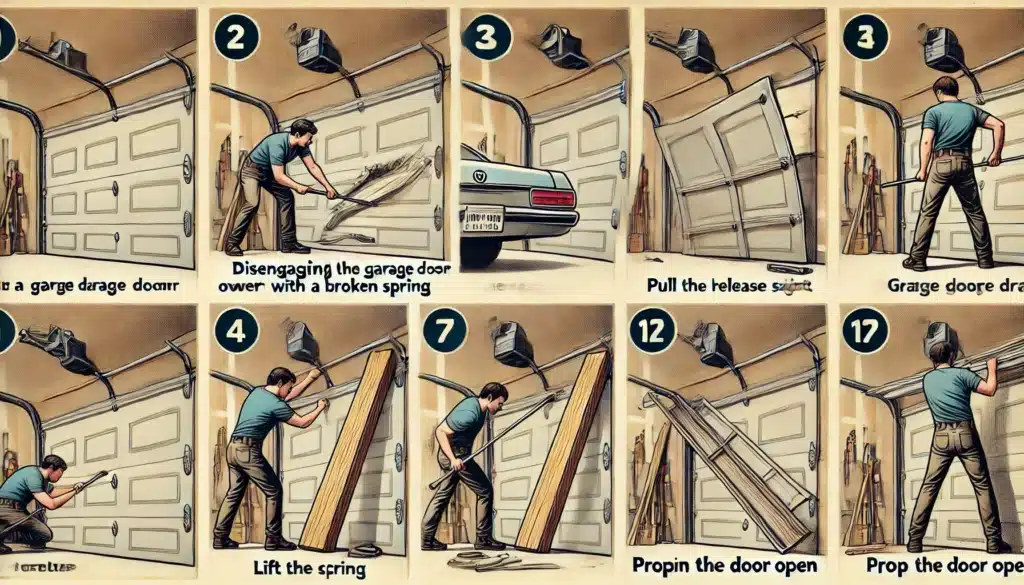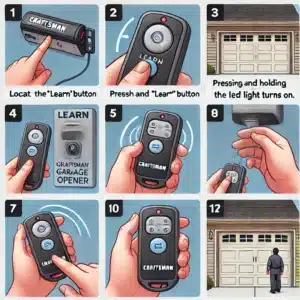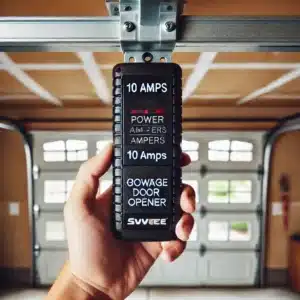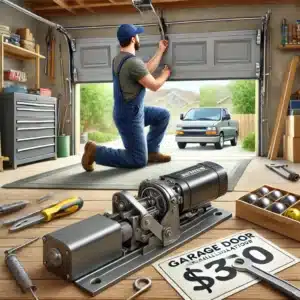Garage doors are essential for home security and convenience. Dealing with a broken garage door spring can be a major hassle. Knowing how to open a garage door with a broken spring is crucial, especially when you need to use your car or secure your home. This guide will walk you through safe methods to manually open your garage door with a broken spring.
Understanding Garage Door Springs
Garage door springs make lifting heavy doors easy. Without them, opening or closing a garage door would require immense effort. There are two main types of garage door springs: torsion springs and extension springs.

Types of Garage Door Springs: Torsion and Extension
Torsion Springs
Torsion springs are mounted above the garage door opening. They twist and coil on a metal shaft, applying torque to balance the door’s weight. Torsion springs are more durable and can handle heavier doors, offering reliability and smoother operation.
Extension Springs
Extension springs run parallel to the horizontal tracks on either side of the door. They stretch and contract to provide the force needed to open and close the door. While simpler and often less expensive than torsion springs, they are more prone to wear and tear.
The Role of Springs in Garage Door Functionality
Garage door springs counterbalance the door’s weight, making opening and closing nearly effortless. They reduce strain on the motor and operator, ensuring smooth and controlled door movement. Without functioning springs, the door would be difficult to lift and could pose serious safety risks.
Signs That a Spring Is Broken
Recognizing the signs of a broken spring can save you from unexpected inconvenience and potential hazards. Here are some common indicators:
- Visible Gap in the Spring: If you notice a gap in the torsion spring or a loose, dangling extension spring, it’s a clear sign of breakage. The gap signifies that the spring has snapped, rendering it ineffective.
- Heavy Door: A garage door that suddenly feels extremely heavy and difficult to lift manually is a major sign that a spring has broken. The springs are no longer providing the necessary support.
- Loud Bang: When a spring breaks, it often does so with a loud, startling bang. This noise is the sound of the spring’s tension releasing abruptly.
- Crooked Door: If the door appears crooked or off-balance when opening or closing, one of the extension springs might be broken. This imbalance is due to one side bearing more weight than the other.
- Slow or Jerky Movements: A garage door that moves slower than usual or has jerky, uneven movements can indicate a problem with the springs.
Safety Precautions
When dealing with a broken garage door spring, safety should be your top priority. Garage doors are heavy and the tension in the springs can make them dangerous to handle without the right precautions. Here’s how to stay safe while managing this issue.
Emphasize the Importance of Safety
A broken garage door spring is not just an inconvenience—it can be a serious hazard. The door itself can weigh hundreds of pounds, and the tension in the springs is powerful enough to cause significant injury. Understanding and respecting this potential danger is crucial.
List Necessary Safety Gear
- Gloves: Heavy-duty work gloves will protect your hands from sharp edges and provide a better grip on the door and tools.
- Safety Glasses: Wear safety glasses to shield your eyes from debris or any sudden movements of the springs.
- Sturdy Shoes: Make sure you’re wearing closed-toe shoes with good traction to prevent slips or drops on your feet.
- Ladder: Use a sturdy, stable ladder to reach high areas safely. Avoid using makeshift steps or chairs.
Importance of Having a Second Person to Assist
Having an extra set of hands is invaluable when dealing with a broken garage door spring.
- Balanced Lifting: The garage door will be heavy and difficult to manage alone. A second person can help lift and balance the door evenly, reducing the risk of dropping it or causing further damage.
- Safety Spotter: Your assistant can act as a spotter, providing an extra layer of safety. They can hold the door steady, pass tools, and help with tasks that require more than two hands.
- Emergency Help: In case of an accident, having someone nearby means immediate help is available.
Manual Operation of the Garage Door
Opening a garage door with a broken spring can seem daunting, but with the right approach, it can be done safely and efficiently. Here’s a step-by-step guide to help you manually open your garage door.
Step-by-Step Guide on How to Manually Open the Garage Door
- Disconnect the Garage Door Opener
- Locate the Emergency Release Cord: This is typically a red rope or cord hanging from the garage door trolley.
- Pull the Cord: Firmly pull the emergency release cord to disengage the door from the opener.
- Locate the Emergency Release Cord: This is typically a red rope or cord hanging from the garage door trolley.
- Position a Ladder or Sturdy Stool for Support
- Choose a Stable Ladder or Stool: Place a sturdy ladder or stool under the garage door. Ensure it is stable and positioned in the center of the door’s path.
- Choose a Stable Ladder or Stool: Place a sturdy ladder or stool under the garage door. Ensure it is stable and positioned in the center of the door’s path.
- Lift the Door Evenly with the Help of Another Person
- Get a Helper: Have a second person assist you. The door will be heavy, and lifting it alone can be risky.
- Position Yourselves: Stand on opposite sides of the door. Grip the bottom of the door firmly.
- Lift Slowly and Evenly: Begin lifting the door together. Keep your movements slow and steady to ensure the door rises evenly.
- Get a Helper: Have a second person assist you. The door will be heavy, and lifting it alone can be risky.
- Secure the Door in the Open Position
- Use Vice Clamps or Locking Pliers: Attach a pair of vice clamps or locking pliers to the tracks just below the bottom rollers.
- Double-Check the Stability: Ensure the clamps are tight and the door is securely held in the open position.
- Use Vice Clamps or Locking Pliers: Attach a pair of vice clamps or locking pliers to the tracks just below the bottom rollers.

Final Safety Check
After securing the door, perform a final safety check. Make sure your support (ladder or stool) is in place and the clamps are holding the door securely. Confirm with your helper that everything looks stable before proceeding to move your vehicle or access items in the garage.
Using Vice Clamps for Support
When dealing with a broken garage door spring, securing the door in an open position is crucial for safety and convenience. Vice clamps are an effective tool for this purpose. Here’s a detailed guide on how to use vice clamps to keep your garage door open and the necessary safety measures to ensure stability.
Detailed Instructions on Using Vice Clamps to Keep the Garage Door Open
- Gather Your Equipment
- Two sturdy vice clamps or locking pliers
- A ladder or sturdy stool
- Two sturdy vice clamps or locking pliers
- Open the Garage Door Manually
- Follow the steps previously outlined to manually lift the garage door. Ensure you have a helper to lift the door evenly.
- Follow the steps previously outlined to manually lift the garage door. Ensure you have a helper to lift the door evenly.
- Position the Vice Clamps
- Identify the Track Location: Locate the vertical tracks on either side of the garage door.
- Place the Clamps Below the Bottom Rollers: Position the vice clamps on the vertical tracks just below the bottom rollers of the garage door.
- Identify the Track Location: Locate the vertical tracks on either side of the garage door.
- Secure the Clamps Tightly
- Adjust the Clamps: Open the clamps wide enough to fit snugly around the tracks.
- Tighten Firmly: Once positioned, tighten the clamps as firmly as possible. The clamps should not move or slip when you let go.
- Adjust the Clamps: Open the clamps wide enough to fit snugly around the tracks.
Safety Measures to Ensure the Door Remains Stable
- Double-Check the Clamps
- Test the Door: Gently push and pull the door to make sure the clamps hold it firmly in place.
- Inspect the Clamps: Ensure the clamps are tightly secured.
- Test the Door: Gently push and pull the door to make sure the clamps hold it firmly in place.
- Secure the Ladder or Stool
- Stable Placement: Ensure the ladder or stool is centered and stable under the door.
- Non-Slip Surface: Use a non-slip mat or place the ladder/stool on a surface that prevents slipping.
- Stable Placement: Ensure the ladder or stool is centered and stable under the door.
- Communicate with Your Helper
- Coordinate Movements: Work together to ensure the door remains balanced and stable.
- Constant Vigilance: Keep an eye on the door and the clamps throughout the process.
- Coordinate Movements: Work together to ensure the door remains balanced and stable.
- Safety First
- Wear Safety Gear: Continue to wear gloves and safety glasses.
- Emergency Plan: Have a plan in case the door starts to move or fall.
- Wear Safety Gear: Continue to wear gloves and safety glasses.
Using vice clamps to secure your new garage door when dealing with a broken spring is an effective and straightforward method. By following these detailed instructions and taking the necessary safety measures, you can ensure the door remains stable and secure.
Temporary Solutions for a Broken Spring
A broken garage door spring can disrupt your day and compromise your garage’s security. While the best long-term solution is to have the spring professionally repaired or replaced, there are several temporary fixes you can implement to manage the situation in the short term.
Overview of Temporary Fixes to Manage the Broken Spring
- Manual Operation and Securing the Door
- Manually lift the door with assistance and secure it with vice clamps.
- Use sturdy objects or support beams to brace the door securely.
- Manually lift the door with assistance and secure it with vice clamps.
- Using a Come-Along Tool
- Attach the Come-Along: Hook the come-along to the door’s frame and a fixed point in the garage.
- Operate the Winch: Use the winch to lift the door gradually.
- Attach the Come-Along: Hook the come-along to the door’s frame and a fixed point in the garage.
- Reinforcing with Temporary Springs
- Acquire Temporary Springs: Purchase temporary garage door springs.
- Install Carefully: Follow the manufacturer’s instructions to install the temporary springs.
- Acquire Temporary Springs: Purchase temporary garage door springs.
- Adding Counterweights
- Prepare Counterweights: Use heavy objects such as sandbags or weight plates.
- Attach Safely: Securely attach the weights to the garage door.
- Prepare Counterweights: Use heavy objects such as sandbags or weight plates.
- Locking the Door in a Closed Position
- Use Locking Mechanisms: Utilize manual locks or bolts to secure the door.
- Block with Objects: Place heavy objects against the door from the inside.
- Use Locking Mechanisms: Utilize manual locks or bolts to secure the door.
Explanation of Each Temporary Solution
- Manual Operation and Securing the Door
- Pros: Provides immediate access; no special tools needed.
- Cons: Requires physical effort and assistance; temporary solution.
- Pros: Provides immediate access; no special tools needed.
- Using a Come-Along Tool
- Pros: Allows for controlled lifting; can handle heavy doors.
- Cons: Requires purchasing or borrowing the tool; not a permanent fix.
- Pros: Allows for controlled lifting; can handle heavy doors.
- Reinforcing with Temporary Springs
- Pros: Offers a more stable solution; mimics the function of the original springs.
- Cons: Requires installation; temporary and may not fit all doors.
- Pros: Offers a more stable solution; mimics the function of the original springs.
- Adding Counterweights
- Pros: Simple and effective; easily adjustable.
- Cons: Not a permanent solution; may be cumbersome.
- Pros: Simple and effective; easily adjustable.
- Locking the Door in a Closed Position
- Pros: Secures the garage; prevents unauthorized access.
- Cons: Limits access to the garage; not a lifting solution.
- Pros: Secures the garage; prevents unauthorized access.
Seeking Professional Help
When dealing with a broken garage door spring, the safest and most reliable solution is to seek professional help. Professional garage door technicians have the expertise and tools to repair or replace broken springs, ensuring your door operates smoothly and safely. Here’s why and how to find the right professional for the job.

Importance of Professional Repair for Safety and Long-Term Functionality
- Expertise and Experience
- Knowledge: Professionals understand the complexities of garage door systems.
- Skill: They have the training to handle various types of springs and doors.
- Knowledge: Professionals understand the complexities of garage door systems.
- Safety
- Risk Mitigation: Professionals can safely handle high-tension springs, reducing the risk of injury.
- Proper Tools: They have the right tools to perform the job safely and efficiently.
- Risk Mitigation: Professionals can safely handle high-tension springs, reducing the risk of injury.
- Quality of Work
- Durability: Professional repairs are more likely to be long-lasting.
- Warranty: Many professionals offer warranties for their work.
- Durability: Professional repairs are more likely to be long-lasting.
- Time and Convenience
- Efficiency: Technicians can complete the job quickly.
- Convenience: You won’t need to invest in tools or spend time on a DIY fix.
- Efficiency: Technicians can complete the job quickly.
How to Find a Reputable Garage Door Repair Service
- Research and Reviews
- Online Reviews: Check reviews on Google, Yelp, and other platforms.
- Word of Mouth: Ask friends, family, or neighbors for recommendations.
- Online Reviews: Check reviews on Google, Yelp, and other platforms.
- Check Credentials
- Licensing: Ensure the technician or company is properly licensed.
- Insurance: Verify that they have insurance to cover any potential damages.
- Licensing: Ensure the technician or company is properly licensed.
- Get Multiple Quotes
- Comparison: Contact several companies to get quotes.
- Evaluate: Compare prices, services, and customer service.
- Comparison: Contact several companies to get quotes.
- Ask for References
- Past Clients: Request references from previous clients.
- Follow-Up: Contact these references to inquire about their experiences.
- Past Clients: Request references from previous clients.
- Verify Experience with Your Door Type
- Specialization: Ensure the technician has experience with your specific type of garage door and spring system.
- Specialization: Ensure the technician has experience with your specific type of garage door and spring system.
- Customer Service
- Responsiveness: Evaluate their responsiveness and willingness to answer questions.
- Professionalism: Assess their professionalism and communication skills.
- Responsiveness: Evaluate their responsiveness and willingness to answer questions.
Frequently Asked Questions
Can I open a garage door with a broken spring by myself?
It’s possible but not recommended due to the risk of injury. Garage doors are heavy and the springs are under high tension. Attempting to open the door alone can be dangerous. Having assistance is crucial to ensure safety and to manage the weight and balance of the door effectively.
How can I tell if my garage door spring is broken?
There are a few signs that indicate a broken garage door spring:
- Gaps in the Spring: Check the springs for any visible gaps. A broken spring will have a noticeable break or separation.
- Heavy Door: If your garage door feels extremely heavy when you try to lift it manually, this is a strong indication of a broken spring.
- Door Won’t Open: If the door won’t open at all, or opens only a few inches, the spring might be broken and not provide the necessary tension to lift the door.
What should I do if my garage door spring breaks?
If you suspect your garage door spring is broken:
- Follow Safety Precautions: Wear safety gear such as gloves and safety glasses.
- Manually Open the Door if Necessary: Use the steps provided earlier to manually open the door, ensuring you have a helper and using vice clamps to secure it.
- Contact a Professional: It’s crucial to get a professional to repair or replace the spring to avoid further damage or injury.
How long do garage door springs typically last?
Garage door springs typically last about 7-9 years or approximately 10,000 cycles (a cycle is one full opening and closing of the door). This lifespan can vary based on factors such as the frequency of use and whether regular maintenance is performed. Proper care can extend the lifespan of the springs.
Is it safe to leave my garage door open if the spring is broken?
It’s not advisable to leave your garage door open if the spring is broken, as it can be a security risk. If you need to keep the door open temporarily, use vice clamps to secure it in place. Ensure the clamps are tightly fastened to prevent the door from falling. However, securing professional repair as soon as possible is the safest and most effective solution.
Conclusion
Understanding how to manage a broken garage door spring is crucial for safely navigating this common issue. Safety should always be the top priority when dealing with garage door repairs. It’s essential to wear protective gear such as gloves and safety glasses, and never attempt to lift the door alone. Temporary solutions like manually lifting the door with assistance and securing it with vice clamps, using tools like a come-along for managing weight, or locking the door in a closed position can provide short-term relief while waiting for professional repairs.
Professional repair remains the most reliable long-term solution for broken garage door springs. Experts have the necessary skills and tools to safely replace springs and inspect the entire system for potential issues. Regular maintenance is also key to extending the lifespan of garage door springs. Conducting visual inspections, lubrication, and balance tests periodically, along with scheduling annual professional inspections, can help identify and address issues early on.
Knowing when to seek professional help is crucial. Signs such as multiple broken springs, difficulty in manually operating the door, unusual noises, or visible damage indicate the need for expert intervention. By staying proactive with maintenance and prompt with repairs, you can ensure the smooth and safe operation of your garage door. For detailed guidance and safety tips on managing a broken garage door spring, refer to our comprehensive instructions to navigate this challenge effectively and responsibly.





